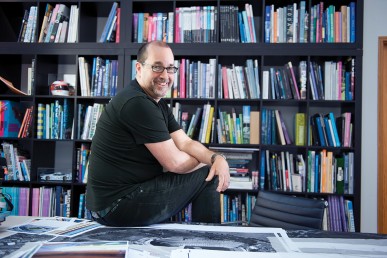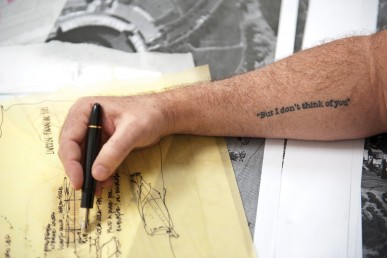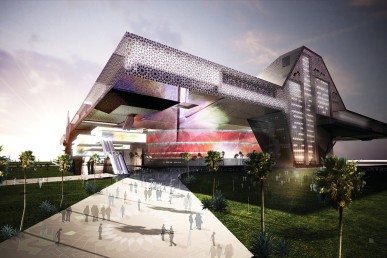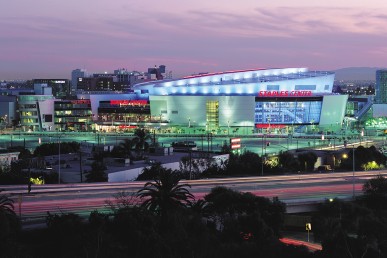The man with the Tatlin’s Tower tattoo

Architect Dan Meis, a 1985 UIC grad, has designed ballparks, arenas and stadiums around the world. Photo: Edward Carreon
By Edward Leibowitz
During one of the more memorable episodes of season two of “LA Ink,” fans of the TLC reality show were thrown a curveball.
Most of the customers were obvious enough: the hard rock guitarist who wanted the cover of his first solo album imprinted on his thigh; the professional poker player who required a Bible verse on her back to remind her of what’s truly important.
But one client went thoroughly against the grain.
Dan Meis, a 1985 graduate of the UIC College of Architecture and the Arts — an architect who is arguably the most influential designer of ballparks, arenas and stadiums in the world — brought with him a drawing of Tatlin’s Tower, a 1917 twisting, animated constructivist monument that looks like the Eiffel Tower thrown into a blender.
Intended to commemorate world communism after the Bolshevik revolution, the monument by Russian artist Vladimir Tatlin was never built but has influenced generations of architects.

Meis’ other tattoo, on his right forearm, highlights the quote, “But I don’t think of you,” taken from Ayn Rand’s seminal novel, The Fountainhead. Photo: Edward Carreon
The base of the Tatlin’s Tower tattoo is visible under Meis’ signature black short-sleeve shirt as we talk this sunny January morning at his Venice Beach office.
Tucked into a side street, Meis’ spare, whitewashed loft doesn’t reveal itself as the workspace of the designer of such high-profile projects as L.A.’s Staples Center. Like the architect himself, it’s casual and unassuming.
For two decades, Meis has created stadiums, arenas and ballparks that, aesthetically and functionally, are designed to look as if they’re on the move, much like the athletes and rock stars who perform in them.
Some of his venues actually do move — shrinking by thousands of seats to accommodate a concert, then expanding again to their full size to host a soccer game.
Meis completed his first expandable stadium 12 years ago, after entering a 1994 design competition for the Saitama Super Arena in Japan. He prevailed over a host of better-known architects, including Rem Koolhaas, Renzo Piano and Richard Rogers.
“I was very conscious of the fact that this stadium would be hemmed in between bullet trains and local trains,” Meis says. “There was something about the fact that this building should be light on its feet and flying along — almost like it’s blurred.
“On the functional side, I stressed the simplicity in the way it transformed. ‘This is a circle, with 20,000 seats, and then you pull it apart and you have 30,000 seats.’ It demystified the notion that this building is transforming.”
The model that inspired a career
Meis grew up in Windsor, Colo., a farming community an hour north of Denver with a population that hovered around 3,000.
He enrolled at the University of Colorado at Boulder, where he studied environmental design. His roommate’s father was a developer in Chicago and Meis visited here on break.

Perhaps Meis’ most ambitious project to date is the Sports City Stadium in Doha, Qatar. Its design inspired by a Bedouin tent, the 46,890-seat stadium will achieve zero carbon emissions. Photo: Courtesy of Populous
“Within minutes, I was entranced by the scale and vibrancy of a city like Chicago,” he says. “I thought, ‘Oh, this is what architecture really is about.’”
For a transfer student from Colorado, attending UIC took some adjustment. At Boulder, the campus was empty on Fridays, as students and faculty took to the ski slopes.
“My first day at UIC, they said, ‘You should plan on pulling an all-nighter every week,’” Meis recalls, “and I’m thinking, ‘Hey, wait a minute.’
“But one thing that had really attracted me to UIC is that it was clear people went here to be practicing architects.”
After graduation, Meis moved to Washington, D.C. The recession of the early 1990s torpedoed the market for office towers and he saw little opportunity to translate any of his designs into brick and mortar.
A friend told him Kansas City-based architectural firm Ellerbe Becket was doing a banner business building stadiums and arenas. Meis had never been a big sports fan, but hoping to actually get something built, he joined the firm.
His first project was the 21,000-seat Manchester Arena, not only the biggest stadium in England, but in all of Western Europe.
Meis relocated to Los Angeles and began changing the landscape of professional sports in the United States as a senior architect, and later, design partner for the NBBJ Sports & Entertainment firm.
His design for the Seattle Mariners’ Safeco Field features a retractable roof that covers the stands and field in steel billows.
Paul Brown Stadium, which he designed for the Cincinnati Bengals, is the only football stadium included on the list of “America’s Favorite 150 Buildings and Structures,” compiled by the American Institute of Architects and Harris Interactive.
Meis designed Miller Park for the Milwaukee Brewers and Lincoln Financial Field for the Philadelphia Eagles.

Meis steered work on one of the best-known sports arenas in the United States, the Staples Center in Los Angeles, home to four professional sports franchises, including the L.A. Lakers. Photo: Courtesy of Populous
Perhaps the most visible of Meis’ works during the late 1990s and early 2000s is the Staples Center, home of the L.A. Lakers and Clippers and the L.A. Kings hockey team.
Billionaire developer and L.A. Kings owner Ed Roski marvels at Meis’ ability to gently steer a project like the Staples Center from utilitarianism into a much more architecturally ambitious realm.
“Dan has a unique ability to take the client’s thoughts and interests and mold them into something beyond — without the client really knowing that he’s doing it,” Roski says.
“It’s a super way to move some stodgy client to a new place, where you’re saying, ‘That’s really good.’”
Currently, most of Meis’ energies are directed towards Sports City Stadium, the massively ambitious project he’s creating for Qatar. The independent Arab nation won the world competition to host the 2022 FIFA World Cup and hired Meis to design not only the transformable stadium for the games, but an entire metropolis built into that stadium’s fabric.
The giant super columns supporting the structure will harbor hotels, offices and shopping centers. Additional commercial space will be embedded into a floating occupied roof, which, despite its enormity, pays homage to a Bedouin tent.
“I clicked with the prince leading the bid,” says Meis.
“He loves the cultural reference of the tent in something that’s truly as cutting edge as any stadium that’s ever been built.”
Tatlin’s Tower may have been Meis’ first tattoo, but it wasn’t his last.
On his right forearm there’s a quote: “But I don’t think of you.”
The line and block-letter font are taken from Meis’ treasured first-edition copy of The Fountainhead. He was introduced to Ayn Rand’s classic novel of defiant individualism after receiving it as a Christmas present while a student at UIC.
The quote comes towards the end of the book.
“For me,” Meis says, “it’s about the fact that you just have to stay true to what you believe in, not let others influence that.”
— UIC Alumni magazine
Categories
